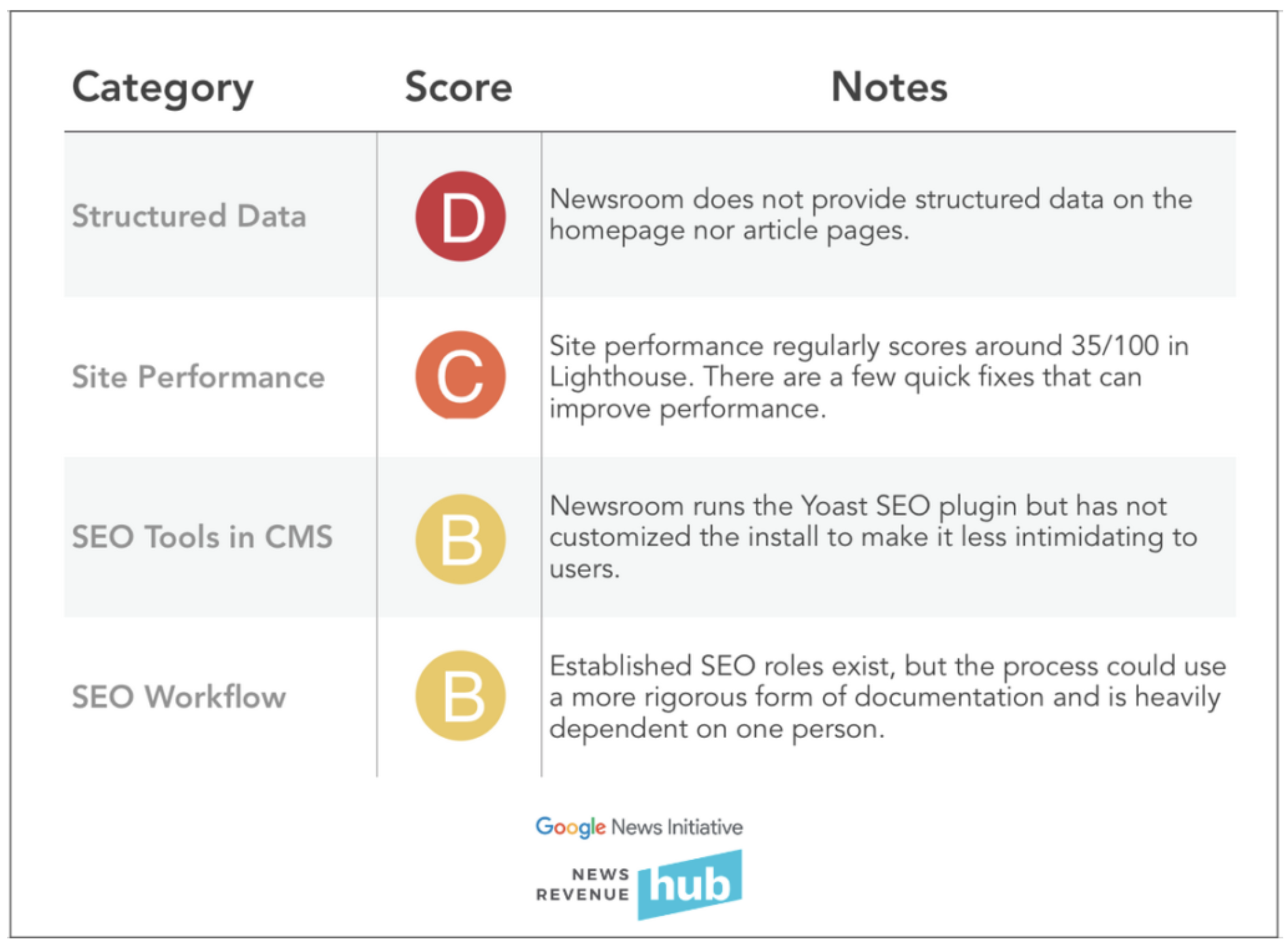The Future Is Audience-First, and Other Takeaways from the GNI Audience Lab
The News Revenue Hub is a nonprofit organization dedicated to helping digital news outlets develop sustainable business models. And when it comes to newsroom sustainability, cultivating audience and loyalty is paramount—as is cultivating a team of experts to do that important work.
That’s why the Hub partnered with the Google News Initiative to create the GNI Audience Lab, a project dedicated to helping publishers grow and enhance their audiences. The Lab’s goal is simple: to help newsrooms find not just new readers, but loyal ones.
Launched in July 2019, the GNI Audience Lab set out to develop a scalable methodology to help small and medium-sized news organizations, who are often resource- and revenue-strapped, implement audience and product development best practices. We recently wrapped up phase one of the cohort-based learning program, and, as we’re kicking off phase two, we’re eager to share our findings so far.
Cohort one was made up of seven newsrooms of varying editorial scopes, staff sizes and business maturity: local outlets Bethesda Beat and Rivard Report; regional publications Bridge Magazine and CalMatters; and national organizations the Center for Public Integrity, the Center for Investigative Reporting, and Next Avenue. The newsrooms participated in the Lab free of charge, with the expectation that they work collaboratively, openly share performance data, and jointly test the feasibility and effectiveness of our recommendations.
To help the first cohort bolster their audience work and focus on enhancing loyal readership, the Lab designed a curriculum that included assessments of four key areas: search discoverability, loyalty funnels, newsletter products, and audience-first culture. Each assessment came with detailed scorecards on a newsroom’s technological and editorial processes, as well as a variety of recommendations on how they could improve, including how they could adopt a more audience-first newsroom culture.
Assessments and Recommendations
For search discoverability and newsletter products, the Lab designed scorecards to provide insights on how to improve qualitative and quantitative metrics. The newsletter scorecards sized up the newsrooms’ audience list health and acquisition rate, and graded them on more aesthetic features, such as design and editorial voice.
For search discoverability, the Lab assessed each website in the cohort against a technology rubric, running each site through free tools, such as Google’s Lighthouse. It also explored and graded editorial workflow, looking closely at whether a newsroom had a process in place for writing SEO-friendly headlines and pitching search-friendly stories.

The Lab also wanted to provide the cohort with greater information about their most loyal visitors—readers who return to their sites multiple times each month. Are the newsrooms growing the number of returning visitors each month? What steps might a newsroom take to make their content more of a habit for readers?
The Lab investigated what steps the newsrooms could take to encourage returning visits using the Google News Initiative’s News Consumer Insights (NCI) framework. Each newsroom was given their own audience analysis and a host of recommendations for how to improve.
A free tool available to any newsroom with a Google Analytics account, NCI provides publishers with a view of a fully integrated audience funnel. Audience teams can zoom in on crucial audience segments—readers who return 2-14 times per month, for example—to examine the breadth of that target group. How large is that readership? Does it align with the newsroom’s expectations? Can they expand this pool of potential donors? NCI assembles crucial metrics, such as sessions-per-user and pages-per-session, to show the newsroom where it might need to focus to improve loyalty. Crucially, it also benchmarks that publication against its industry peers, so it can compare its performance against an average and best-in-class.
We found that while most of the cohort members were accustomed to looking at some combination of audience metrics, focusing on specific analytics that move the needle on loyalty helped to cut through the chaos of what can seem like a dizzying web of stats.
Tools and Resources
In addition to scorecards and diagnostics, the Lab produced a number of tools and resources to help the cohort gain a foothold on tackling its recommendations. Our SEO Cheat Sheet outlines best practices on writing search headlines and other search-friendly terms, for example. The cheat sheet is designed to be handed out to editors and copywriters that frequently take the first pass on such processes.

The Lab also did a cohort-wide SEO training call to help audience development teams master SEO before training their editors. As a next step, the Lab is lining up a more customized SEO training for newsrooms that want help training their editorial staff.
In addition, the Lab created a ‘mid-funnel menu’ to highlight strategies that improve returning visitor metrics. Drawing from the NCI Playbook, the menu highlights best practices for recirculation, newsletter sign-ups, and more experimental strategies, such as web push notifications.
It’s also established a traffic-spike toolkit that will help audience teams develop plans that will make the most of viral stories. Audience teams will create strategies that place customizable recirculation links and newsletter prompts tailored to the casual audiences that flood a site when an article goes viral, in an effort to get those readers to come back to the site.
Three Major Takeaways
Throughout this process, there were some big takeaways and early wins:
1. Cultivate an audience-first culture. Newsrooms must nurture talented, well-trained people to do audience work, and these staffers need a mandate to ensure their strategies are hardwired into newsrooms’ organizational structures and workflows. While all members of the first cohort bought in to the importance of audience development, many did not have the dedicated personnel in place to execute recommendations. Some were too strapped for time to attempt new strategies. Others were hamstrung by a conservative newsroom culture where editors primarily dictate audience strategy. Creating a collaborative audience-first culture is crucial, and is something we’re addressing from the start with our second cohort.
Here’s an early win: In January, Rivard Report, a local site in San Antonio, TX, hired their first audience strategist, and the Lab helped them think through how to bring focus to the position and write the job description.
“When we started talking about adding an audience position, we didn’t really know where to begin. It was the first time we had started thinking critically about our audience and we wanted to make sure we put the right person in that spot,” said Rivard Report Managing Editor Graham Watson-Ringo. “Fueled by Lab assessments on SEO and newsletters that highlighted our good and bad, we were able to pinpoint the areas on which we wanted to focus, put those into the job description and hire an internal candidate to lead the charge. And the Lab help didn’t stop there. It has created an environment of support for our audience editor, which has helped him adjust quicker than he would have been able to on his own. So we’ve really hit the ground running.”
2. Achieve results by staying focused. Newsrooms with limited resources need their audience teams to identify the top three growth areas, and stay focused on them. We recommend that publishers pay attention to loyalty analytics, newsletters, and discoverability.
The Center for Investigative Reporting seized on the opportunity to overhaul its SEO workflow during the Lab. “We had limited SEO infrastructure in place before we started working with the Audience Lab,” says Hannah Young, CIR’s Audience Director. As a part of the first Lab cohort, we’ve implemented a stronger SEO workflow into our editorial processes, made website improvements and paid down some of the SEO debt from our back catalog. We’re still early on in seeing how these changes impact our site traffic overall, but our work with the Lab helped us quickly uplevel our SEO literacy, workflow and infrastructure.”
3. Don’t overlook the middle of the funnel. Here’s how focused the Lab is on loyalty: Even when we tackled search discoverability, a major avenue for casual readers, we emphasized the importance of converting those new readers into habitual ones. The Lab followed its SEO assessment with UX tips from the News Consumer Insights playbook to help newsrooms cultivate a relationship with new readers coming from search. Strengthening recirculation, optimizing newsletter signups, and even offering web push notifications are just a few of the strategies we emphasized to bolster the middle of the funnel by getting readers to stay on the site or to come back.
Bill Emkow, audience strategist at Bridge Michigan has focused on enhancing search discoverability on the site, while also testing out user experience strategies offered to optimize on-site email modals. That 1-2 punch helped bolster search traffic to the site and increase conversion rates for an email sign-up specifically designed to target search traffic by more than 250 percent over four months. So when search traffic flooded the site in February following an SEO improvement, his modal was primed to move those casual readers on to the email list. The result? Hundreds of new email subscribers.
Members of cohort one will continue to work on product improvements throughout phase two of the Lab, and we will continue to report on their progress.
An Audience-First Future
The implementation and execution challenges we experience as we work toward a more audience-first newsroom culture are common across the digital news industry and shouldn’t be underestimated. But that doesn’t mean they are insurmountable! To be successful—to even survive—in the next decade, many newsrooms will have to make conscientious audience development strategy adjustments.
We believe that the work we’re doing with GNI can help pave the way for newsrooms. We’re already applying our learnings and looking forward to racking up even more wins with our second cohort: Daily Memphian, DCist, Denverite, The Capital Times of Madison, Wisconsin, Crosscut of Washington state, MinnPost, Mississippi Today, and #ThisIsTucson. The assessments are underway and the work will continue until August.
The Lab team is working intensely with both cohorts to support their efforts during the coronavirus epidemic. Now, more than ever, newsrooms need to pay attention to how they can capitalize on their increasing traffic to turn new readers into loyal ones. Last week, the Lab teamed up with the News Revenue Hub to hold a webinar to offer tips on how audience and membership teams could best manage this moment, when newsrooms are stretched thin but also seeing unprecedented traffic coming to their sites.
It was a great example of the Lab’s audience-first ethos: especially during these uncertain times, it’s imperative that audience teams have the knowledge and mandate to take charge and incorporate strategies to build loyalty with their readers. After all, if they don’t, who will?